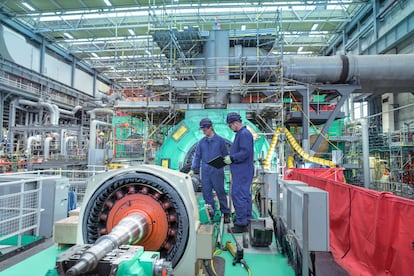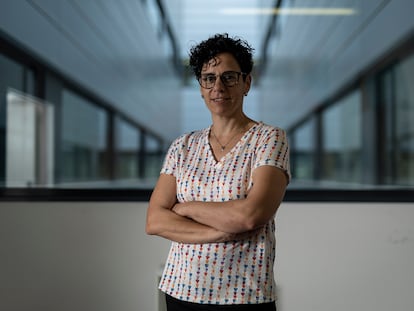A study with 300,000 workers in the nuclear industry suggests an increased risk of death from cancer
The analysis shows that prolonged exposure to low doses of radiation can be just as harmful as the same amount received all at once

Prolonged exposure to low doses of ionizing radiation is associated with a higher risk of death from cancer than previously thought, according to a study of nearly 310,000 nuclear industry workers in France, the United Kingdom, and the United States. The mortality rate from solid tumors increases by 52% at 10 years for each accumulated gray, a unit of absorbed radiation that is equivalent to 1,000 millisieverts, or about 10,000 chest X-rays. The individual risk, however, remains very low.
Epidemiologist Amy Berrington, who was not involved in the research, provides an example. “For every 1,000 people exposed to 100 millisieverts of ionizing radiation — most nuclear workers are exposed to less than 10 millisieverts — there could be an extra 10 deaths, instead of five, on top of the more than 200 expected deaths from tumors produced by other causes,” Berrington explained to the Science Media Centre portal. “Twice a small risk is still a small risk,” stressed the epidemiologist, from the Institute for Cancer Research, in London.
The new study includes data from workers in the nuclear industry between 1944 and 2016. The authors analyzed almost 104,000 deaths, more than 28,000 of them caused by solid tumors, which included the most common types of cancer, except leukemia. The mortality rate from these tumors increased by 52% for each accumulated gray, but doubled when the analysis was restricted to workers receiving lower doses of less than 100 milligrays. The signatories — led by epidemiologist Mary Schubauer-Berigan, from the International Agency for Research on Cancer — trust that their results will help improve radiation protection measures in sectors such as the nuclear industry, scientific research, and medicine.
The risk of cancer from a given dose of radiation has historically been deduced from the survivors of the atomic bombs dropped by the United States on the Japanese cities of Hiroshima and Nagasaki in 1945, at the end of World War II. These people, however, received most of the radiation within one second, according to Jim Smith, an expert in radioactivity at the University of Portsmouth in the United Kingdom. “It has long been assumed that chronic exposures to low doses of radiation, with the same amount absorbed, are between 1.5 and two times less harmful than acute exposures, such as those of atomic bomb survivors,” he reported to the Science Media Center. “The results of this important study support the evidence accumulated over the past few decades that long-term chronic doses are actually likely to be as detrimental as acute doses, in terms of cancer risk per amount of radiation absorbed by the organism,” says Smith.
Everyone exposed to ionizing radiation, but most of it comes from natural sources. The average dose in the Spanish population is 3.7 millisieverts per year, 64% of which (2.4 millisieverts) comes from natural radiation, according to data from the Nuclear Safety Council. Cosmic rays are responsible for an average dose of 0.39 millisieverts, a figure that is increased in frequent travelers on transoceanic flights. Radon gas, that comes from the uranium present in the subsoil, generates an average dose of 1.15 millisieverts. And X-ray diagnostic techniques reach an average dose of 1.2 millisieverts. Living near a nuclear power plant is barely 0.005 millisierverts, according to the United Nations Scientific Committee for the Study of the Effects of Atomic Radiation.
The new study was published this Thursday in the specialist journal The BMJ. Among the signatories is the epidemiologist Isabelle Thierry Chef, head of the Medical Radiation group at the Barcelona Institute for Global Health. The team already published similar work in 2015. Their results suggested a 48% increase in the estimated death rate from cancer, excluding leukemia, for each gray. The authors then calculated that about 200 of the 19,000 solid tumor deaths observed were associated with excess exposure to artificial radiation.
Epidemiologist David Richardson, one of the study’s lead authors, gives another example. “A worker might receive occupational exposure to ionizing radiation of 20 milligrays per year for five years: 100 milligrays cumulatively. If the estimated mortality rate from solid tumors increases by 52% for each gray, this implies an increase of 5% after an exposure of 100 milligrays,” explains Richardson, of the University of California at Irvine. The epidemiologist stresses that one out of every 100 deaths observed due to solid tumors among nuclear industry workers is due to this excess radiation exposure, according to that previous analysis. “This new study strengthens the evidence for the link between cancer and ionizing radiation. If you are currently working with radioactive materials, contact your occupational risk manager if you have questions about how best to protect yourself,” he says.
The work published this Thursday by the team led by Mary Schubauer-Berigan once again dismantles the idea that singular, high doses of radiation, such as those received by the survivors of Hiroshima and Nagasaki, are more harmful than low and prolonged doses. “Our study has found no evidence of a lower risk of solid tumors, per unit dose, among workers routinely exposed to low doses of radiation,” the authors note.
Sign up for our weekly newsletter to get more English-language news coverage from EL PAÍS USA Edition
Tu suscripción se está usando en otro dispositivo
¿Quieres añadir otro usuario a tu suscripción?
Si continúas leyendo en este dispositivo, no se podrá leer en el otro.
FlechaTu suscripción se está usando en otro dispositivo y solo puedes acceder a EL PAÍS desde un dispositivo a la vez.
Si quieres compartir tu cuenta, cambia tu suscripción a la modalidad Premium, así podrás añadir otro usuario. Cada uno accederá con su propia cuenta de email, lo que os permitirá personalizar vuestra experiencia en EL PAÍS.
¿Tienes una suscripción de empresa? Accede aquí para contratar más cuentas.
En el caso de no saber quién está usando tu cuenta, te recomendamos cambiar tu contraseña aquí.
Si decides continuar compartiendo tu cuenta, este mensaje se mostrará en tu dispositivo y en el de la otra persona que está usando tu cuenta de forma indefinida, afectando a tu experiencia de lectura. Puedes consultar aquí los términos y condiciones de la suscripción digital.
More information
Archived In
Últimas noticias
Maduro pleads not guilty before the federal court in New York: ‘I am still the president of Venezuela’
A new test can detect Alzheimer’s from a finger prick
UN team enters Sudanese city of El Fasher after paramilitary massacre: ‘It’s like a ghost town’
A recipe for resistance: Indigenous peoples politicize their struggles from the kitchen
Most viewed
- Gilles Lipovetsky: ‘If you want to live better and fall in love, take Prozac, don’t look to philosophy’
- Alain Aspect, Nobel laureate in physics: ‘Einstein was so smart that he would have had to recognize quantum entanglement’
- Alvin Hellerstein, a 92-year-old judge appointed by Bill Clinton, to preside over Maduro’s trial in New York
- Maduro’s downfall puts China’s relationship with Venezuela to the test
- Why oil has been at the center of Venezuela-US conflicts for decades










































